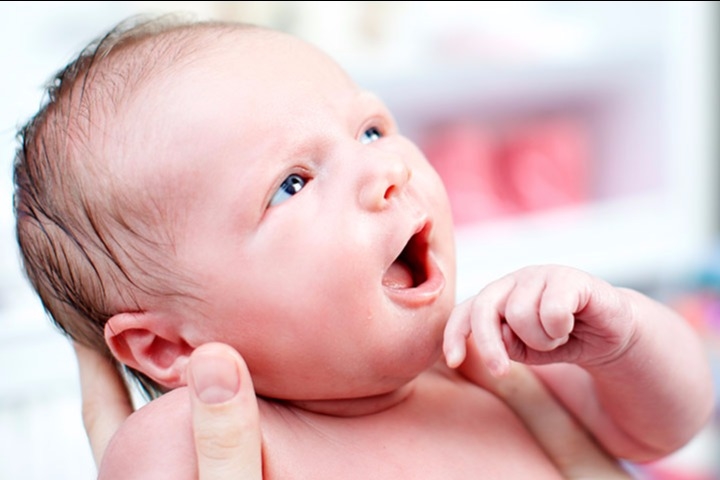
Baby’s Development milestones: Birth-2 months
18 Feb 2016 | 5 min Read
Baby Chakra
Author | 501 Articles
The different milestones in the first important year of your child’s life are very critical for you to know. There are three main areas that you should be looking at:
1. Motor development: which deals mainly with movements and manipulation of different parts of the body.
2. Perception and social responses related to the child’s sensory system, ability to comprehend and social behavior.
3. Speech
Here’s a low-down on the different stages of a baby’s development:
New Born Baby
No two newborns are the same. Some fuss more, some sleep less and some cry more than others. However, they all like to be cuddled and loved.
1. Motor Development
While lying on her back without a pillow, the baby mostly keeps her head to one side. When put on her stomach, she raises her head momentarily and makes an effort to turn it to one side.
With a gentle push to her sole, she may appear to crawl.
In general, she keeps her hands fisted. If you put your finger in her palm, she grasps it firmly (the grasp reflex).
When made to stand on a firm surface, she takes a few steps as if she were walking (the walking reflex). The walking reflex may not be well elicited if the child is not fully awake. The grasp reflex and the walking reflex disappear in about 2 months.
Source: webdesignburn.com
2. Perception and Social Response
The newborn wrinkles her forehead and blinks when subjected to strong light and sound. She may also suddenly move her arms outwards and start crying.
A crying baby usually stops crying the moment you cuddle her in your arms. Suckling at the breast offers mutual satisfaction to the mother as well as the baby. It gives the newborn comfort and a feeling of security, besides fulfilling her nutritional needs.
Speech
The lusty cry of a baby due to hunger or any discomfort may herald the development of speech in due course of time.
One Month
1. Motor Development
While on her back, the child kicks her legs in joy. When put on her stomach, she lifts her head and turns it to one side to spare her nose. When held up against your shoulder, she lifts her head momentarily away from your shoulder. Her hands are fisted. She can now bring her hand within the range of her eyes.
2. Perception and Social Response
If a brightly-coloured rattle or a ring is moved 20 cms in front of the child’s face, she fixes her gaze on it. If you move it from midpoint to one side, she follows it with her eyes. She may not respond the first time you show her the rattle; repeat the action a few times if required. If the baby is lying on her back, she may follow you, within the range of her eyesight. Her eyes may move from one side to the other and sometimes it may appear that she has a squint. This is often transitory and disappears by the age of 5 or 6 months. At this age, she gives more attention to black and white pictures.
Source: doc-advice.com
In a quiet place, shake a rattle about 8 cms away from the baby’s ear. She will respond to the sound by wrinkling her forehead, stopping any activity that she is doing, suddenly blinking, or by crying. On completing 1 month, the child’s hearing is fully matured. She even seems able to differentiate between some sounds.
This is why it might have helped if you had read aloud to your baby during the last 1 or 2 months of pregnancy. After your baby is born, if the same story is read to her when she is awake and about a month old, you will be pleasantly surprised. She may become quiet and more attentive as if she is listening to a sound that she can recognize.
Suckling at the breast and feeling secure in her mother’s arms, the baby looks lovingly at her mother’s face and often manages to have eye contact with her.
3. Speech
The child may make some throaty sounds like ‘ah’ and ‘coo’.
Two Months
1. Motor Development
When put on her stomach, the child lifts her head at an angle of about 45 degrees and can hold it there for about 10 seconds. When held up against the shoulder, she can now keep her head up for a little longer. The first is now kept open more often.
2. Perception and Social Response
The child listens to sounds more attentively. She sows a more mature response by pausing when she hears the rattle and does not blink or show any signs of fear.
The first smile of the child in response to your smile is noticed at around 6 weeks of age. This social smile should not be confused with the spontaneous smiles of babies during the first week of life.
Source: thequinntessentialmommy.com
3. Speech
The child may make a few throaty sounds such as goo, ab and coo.
Also read more about: Baby’s Development: 3-4 Months, 5-6 Months, 7-8 Months, 9-10 Months, 11-12 Months, 2- 5 Year
Source: Book – Guide to Child Care by Dr R K Anand
To consult Dr R K Anand in person, click here
Source for banner image: momjunction.com
A


Suggestions offered by doctors on BabyChakra are of advisory nature i.e., for educational and informational purposes only. Content posted on, created for, or compiled by BabyChakra is not intended or designed to replace your doctor's independent judgment about any symptom, condition, or the appropriateness or risks of a procedure or treatment for a given person.
